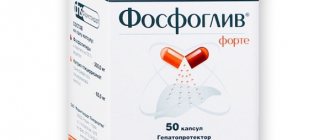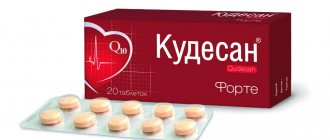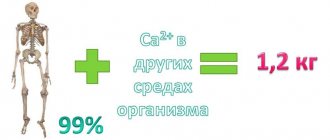Pharmacological properties
Pharmacodynamics
Cavinton Forte is a cerebrovasodilating agent that improves brain metabolism and increases the consumption of glucose and oxygen by its tissue. Vinpocetine, the active ingredient of the drug, increases the resistance of neurons to hypoxia by enhancing the transport of glucose across the blood-brain barrier (BBB) to the brain. The drug promotes the process of glucose breakdown along an energetically more economical, aerobic pathway, selectively inhibits Ca2+/dependent phosphodiesterase (PDE), and leads to an increase in the level of cyclic guanosine monophosphate (cGMP) and adenosine monophosphate (AMP) in the brain.
Vinpocetine promotes an increase in the concentration of adenosine triphosphate (ATP) and the ratio of ATP to AMP in brain tissue, and also enhances the metabolism of norepinephrine and serotonin. Activates the ascending branch of the noradrenergic system and demonstrates an antioxidant effect. Thanks to the action of the drug, platelet aggregation and increased blood viscosity are reduced, the deforming effect of erythrocytes increases and the utilization of adenosine by erythrocytes is blocked. Vinpocetine enhances the neuroprotective effect of adenosine and increases the delivery of oxygen to red blood cells.
Cavinton forte leads to an increase in cerebral blood flow and a decrease in vascular resistance of the brain, without significantly affecting such indicators of systemic circulation as heart rate (HR), blood pressure (BP), minute volume, and general peripheral resistance. Vinpocetine not only does not cause the steal effect, but also improves blood flow, mainly to ischemic areas of the brain with low perfusion.
Pharmacokinetics
The maximum concentration (Cmax) of vinpocetine in blood plasma is observed 1 hour after oral administration. The drug is absorbed mainly in the proximal parts of the gastrointestinal tract (GIT). Passing through the intestinal wall it is not metabolized. In tissues, Cmax of the drug is observed 2–4 hours after oral administration, bioavailability is approximately 7%.
Against the background of repeated doses of 5 and 10 mg, the active substance demonstrates linear kinetics, binding to plasma proteins is 66%. Cavinton forte penetrates the placental barrier. The clearance of the drug, 66.7 l/h, exceeds the plasma volume of the liver (50 l/h), which is evidence of its metabolism occurring outside the liver. The half-life is 4.83±1.29 hours, the drug is excreted in feces and urine in a ratio of 2:3.
"Cavinton" with VSD
Despite the fact that the effectiveness for eliminating neurocirculatory dystonia has not yet been confirmed, it is nevertheless believed that this drug has a good pharmacological effect in this disease.
Factors that cause the development of vegetative-vascular dystonia include brain injuries, as well as chronic intoxication with harmful substances, overwork, and abuse of drugs that narrow the capillaries of the brain.
"Cavinton" helps reduce vascular spasm and increases the brain's resistance to various toxic substances. In addition, the drug lowers blood pressure, which is usually elevated during attacks of vegetative-vascular dystonia, according to patient reviews.
Indications for use
- neurology – symptoms of mental and neurological disorders (in order to reduce severity) against the background of various forms of cerebral circulatory insufficiency, which include the consequences of a stroke, the recovery stage of hemorrhagic stroke, conditions after an ischemic stroke, transient ischemic attack, cerebral atherosclerosis, vertebrobasilar insufficiency , vascular dementia, post-traumatic and hypertensive encephalopathy;
- ophthalmology – chronic vascular pathologies of the organ of vision: lesions of the retina and choroid;
- otorhinolaryngology – idiopathic tinnitus, perceptual hearing loss, Meniere's disease.
Analogs
The drug Cavinton Forte has several popular and effective analogues that can be easily found on the shelves of pharmacy chains. Among the well-known medicinal substitutes are the following:
Neurovin
Direct structural substitute for Cavinton forte. Unlike the original medication, Neurovin is available not only in a dosage of 10 mg, but also in 5 mg of vinpocetine per tablet. Due to the full compliance of indications and contraindications for the use of medications, Neurovin can act as a complete substitute for Cavinton Forte during the treatment process.
Kwanil
Available in the form of film-coated tablets. The active substance is citicoline sodium. It is used in the treatment of the consequences of traumatic brain injuries, stroke, acute periods of cerebral circulatory disorders, cognitive and behavioral disorders against the background of degenerative brain and chronic vascular disorders. Contraindicated in case of hypersensitivity, excessive tone of the parasympathetic nervous system, pregnancy, lactation and in the treatment of children under 18 years of age.
Lutsetam
A tablet containing piracetam. It is used in the treatment of cognitive disorders, cerebrovascular accidents, memory impairment and cortical myoclonus, both as a single drug and as a component of complex treatment. Lucetam is contraindicated in end-stage renal failure, pregnancy, acute cerebral circulatory disorders, lactation, hypersensitivity, Huntington's chorea and in pediatric practice.
Side effects
During the use of the product, in rare cases, the following violations were noted:
- nervous system: increased drowsiness/insomnia, headache, dizziness, general weakness (these effects may also relate to manifestations of the underlying disease), increased sweating;
- cardiovascular system: changes in the electrocardiogram (ECG), manifested by prolongation of the QT interval, depression of the ST segment; extrasystole, tachycardia (however, the causal relationship between the occurrence of these reactions and the use of the drug has not been proven, since in the natural population they occur with the same frequency), sensation of hot flashes, blood pressure lability;
- allergic reactions: urticaria, skin rash;
- digestive system: nausea, dry mouth, heartburn.
Cavinton and alcohol
The drug and alcoholic beverages have poor compatibility, since such interactions on the human body are different and contradictory. If you neglect this rule, the consequences can be disastrous. According to the instructions for use for Cavinton, side effects in this situation most often occur from the heart.
Therefore, after drinking alcohol, you need to wait time to eliminate it. You can take alcohol-containing drinks once you have completed the course of therapy.
special instructions
Patients with long QT syndrome due to concomitant use of drugs that prolong the QT interval should undergo periodic ECG monitoring.
If you have lactose intolerance, please take into account that one Cavinton forte 10 mg tablet contains 83 mg of lactose monohydrate.
Impact on the ability to drive vehicles and complex mechanisms
Data on the effect of Cavinton Forte on the ability to drive a car and other complex mechanisms are not provided.
Dosage
As a rule, stepwise therapy is used, initially the drug is administered intramuscularly or intravenously, then the course of treatment is continued with tablet forms. However, changes to the dosage regimen are possible. IV and IM are administered only after dilution (saline solution, Ringer's solution, etc.). It is administered intravenously slowly, drip-wise, over 3 hours after dilution.
Initial dosages should be 20-25 mg; if well tolerated, the dose may be increased to 1 mg per kilogram of body weight. The course of treatment is 10-14 days.
At the end of the injection course, it is recommended to continue therapy with Cavinton Forte tablets (1 tablet three times a day) or Cavinton (2 tablets three times a day). The tablets are taken orally, preferably after meals.
The therapeutic effect develops approximately a week from the start of taking the drug. The course of treatment with tablets can range from 1 to 3 months. For liver and/or kidney diseases, the dose of the drug and the duration of the course of treatment do not change (there is no cumulation effect).
Use during pregnancy and lactation
During pregnancy, taking Cavinton forte is contraindicated, since vinpocetine crosses the placenta. It has been established that the level of the active substance in the placenta and in the blood of the fetus is lower than in the blood of the mother. When using high doses, placental bleeding and spontaneous abortions may occur, presumably due to increased placental blood supply.
Over the course of 60 minutes, 0.25% of the dose taken is excreted into breast milk; therefore, during lactation, if it is necessary to use the drug, it is necessary to stop breastfeeding.
Contraindications
Cavinton forte is contraindicated in conditions such as:
- pregnancy;
- acute phase of hemorrhagic stroke;
- breastfeeding period;
- severe form of ischemic heart disease;
- lactose intolerance, lactase deficiency, galactose/glucose malabsorption;
- hypersensitivity or intolerance to vinpocetine or excipients of the dosage form;
- severe form of arrhythmia;
- children under 18 years of age.
Reviews about Cavinton Fort
Reviews about Cavinton Forte are overwhelmingly positive; patients note significant improvements after a full course of treatment with this remedy. According to many reviews, the drug effectively helps in the treatment of neurological or mental disorders caused by cerebrovascular insufficiency. It relieves headaches, dizziness, tinnitus, normalizes blood pressure, improves memory, sleep quality and overall well-being. To reduce possible adverse reactions, almost all patients recommend starting the course with the lowest effective doses.
At the same time, there are reviews that indicate a complete lack of effect when using the drug. The disadvantages of the drug also include the development of side effects, the most common of which are nausea, dry mouth, loss of appetite, drowsiness, lethargy, decreased blood pressure, increased heart rate, and headache.
Description and composition
Cavinton Forte is a flat-cylindrical tablet of white or almost white color with a dividing strip, chamfer and engraving “10mg” on one side.
1 tablet contains 10 mg of vinpocetine.
Auxiliary components:
- corn starch;
- lactose monohydrate;
- magnesium stearate;
- colloidal silicon dioxide;
- talc.
Instructions:
Clinical and pharmacological group
02.056 (Drug that improves blood circulation and brain metabolism)
Release form, composition and packaging
The tablets are round, flat, white or almost white, with a bevel, with the inscription “10 mg” on one side and with a score on the other.
| 1 tab. | |
| vinpocetine | 10 mg |
Excipients: magnesium stearate, colloidal silicon dioxide, talc, lactose monohydrate, corn starch.
15 pcs. - blisters (2) - cardboard packs. 15 pcs. - blisters (6) - cardboard packs.
pharmachologic effect
A drug that improves cerebral circulation. Improves brain metabolism by increasing the consumption of glucose and oxygen by brain tissue. Increases the resistance of neurons to hypoxia, enhancing the transport of glucose to the brain through the BBB; transfers the process of glucose breakdown to the more energy-efficient aerobic pathway; selectively blocks Ca2+-dependent phosphodiesterase; increases levels of AMP and cGMP in the brain. Increases the concentration of ATP and the ATP/AMP ratio in brain tissue; enhances the exchange of norepinephrine and serotonin in the brain; stimulates the ascending branch of the noradrenergic system and has an antioxidant effect.
Reduces platelet aggregation and increased blood viscosity; increases the deforming ability of red blood cells and blocks the utilization of adenosine by red blood cells; helps increase oxygen delivery by red blood cells. Strengthens the neuroprotective effect of adenosine.
Increases cerebral blood flow; reduces the resistance of cerebral vessels without significant changes in systemic circulation parameters (BP, minute volume, heart rate, peripheral vascular resistance). Not only does it not have a “stealing” effect, but it also increases blood supply, primarily in ischemic areas of the brain with low perfusion.
Pharmacokinetics
Suction
After oral administration, it is quickly absorbed. Cmax in blood plasma is achieved 1 hour after administration. Absorption occurs mainly in the proximal gastrointestinal tract. When passing through the intestinal wall it is not metabolized. Cmax in tissues is observed 2-4 hours after oral administration. Bioavailability is 7%.
Distribution
With repeated oral doses of 5 mg and 10 mg, the kinetics are linear.
Binds to plasma proteins by 66%. Penetrates through the placental barrier.
Metabolism and excretion
Clearance of 66.7 l/h exceeds the plasma volume of the liver (50 l/h), indicating extrahepatic metabolism.
T1/2 is 4.83±1.29h. Excreted in urine and feces in a ratio of 3:2.
Dosage
The duration of treatment and dose are determined individually.
The average daily dose is 15-30 mg (5-10 mg 3 times a day). The initial daily dose is 15 mg. The maximum daily dose is 30 mg.
The therapeutic effect develops approximately a week from the start of taking the drug. It takes three months to achieve the full therapeutic effect.
In case of impaired renal and liver function, no adjustment of the dosage regimen is required; the absence of accumulation allows for long courses of treatment.
Overdose
Currently, data on overdose of Cavinton® Forte are limited.
Treatment: gastric lavage, taking activated carbon, symptomatic therapy.
Drug interactions
No interaction is observed when used simultaneously with beta-blockers (chloranolol, pindolol), clopamide, glibenclamide, digoxin, acenocoumarol and hydrochlorothiazide, imipramine.
The simultaneous use of Cavinton® Forte and methyldopa sometimes caused a slight increase in the hypotensive effect, therefore, when using this combination, regular blood pressure monitoring is required.
Despite the lack of data confirming the possibility of interaction, it is recommended to exercise caution when prescribing Cavinton Forte simultaneously with centrally acting drugs, antiarrhythmics and anticoagulants.
Use during pregnancy and lactation
Cavinton® Forte is contraindicated for use during pregnancy, because Vinpocetine penetrates the placental barrier. Moreover, its concentration in the placenta and in the blood of the fetus is lower than in the blood of a pregnant woman. When taken in high doses, placental bleeding and spontaneous abortion may develop, probably as a result of increased placental blood supply.
Within 1 hour, 0.25% of the administered dose of the drug is excreted in breast milk. If it is necessary to use the drug during lactation, breastfeeding should be stopped.
Side effects
From the cardiovascular system: ECG changes (ST depression, prolongation of the QT interval); tachycardia, extrasystole (however, the presence of a causal relationship has not been proven since in the natural population these symptoms are observed with the same frequency); lability of blood pressure, feeling of hot flashes.
From the central nervous system: sleep disturbances (insomnia, increased drowsiness), dizziness, headache, general weakness (these symptoms may be manifestations of an underlying disease), increased sweating.
From the digestive system: dry mouth, nausea, heartburn.
Allergic reactions: skin rash, urticaria.
Storage conditions and periods
List B. The drug should be stored in a place protected from light, out of reach of children at a temperature of 15° to 30°C. Shelf life: 5 years.
Indications
- to reduce the severity of neurological and mental symptoms in various forms of cerebral circulatory insufficiency (including conditions after an ischemic stroke, the recovery stage of hemorrhagic stroke, the consequences of a stroke, transient ischemic attack, vascular dementia, vertebrobasilar insufficiency, cerebral atherosclerosis, post-traumatic and hypertensive encephalopathy);
— chronic vascular diseases of the eyes (damages of the choroid and retina);
- in otorhinolaryngological practice (for the treatment of perceptual hearing loss, Meniere's disease, idiopathic tinnitus).
Contraindications
- acute phase of hemorrhagic stroke;
- severe form of ischemic heart disease;
- severe arrhythmias;
- pregnancy;
- lactation (breastfeeding);
- children under 18 years of age;
- hypersensitivity to vinpocetine or other components of the drug.
special instructions
The presence of prolonged QT interval syndrome and simultaneous use of drugs that cause prolongation of the QT interval require periodic ECG monitoring. In case of lactose intolerance, it should be taken into account that one tablet of Cavinton® Forte contains 83 mg of lactose monohydrate.
Use in pediatrics
The drug Cavinton® Forte should not be prescribed to children and adolescents under the age of 18 years due to insufficient data on its use in this category of patients.
Impact on the ability to drive vehicles and operate machinery
There is no data on the effect of taking Cavinton® Forte on the ability to drive a car or operate machinery.
Use for renal impairment
In case of impaired renal function, no adjustment of the dosage regimen is required; the absence of accumulation allows for long courses of treatment.
Use for liver dysfunction
In case of liver dysfunction, no dosage adjustment is required.
Conditions for dispensing from pharmacies
The drug is available with a prescription.
Opinions
Reviews about the drug are mixed. Patients who took Cavinton report that it helps, but there are statements that no positive effect from the therapy was noticed. The advantage is the low cost of the drug. In addition, patients note the occurrence of adverse reactions.
It must be remembered that Cavinton should not be given to children. But at the same time, doctors still take risks and prescribe this medication to young patients. Feedback from parents indicates that when children take the drug, unwanted side effects appear, such as irritability and insomnia.
According to patient reviews of Cavinton, side effects most often manifest themselves in the form of high blood pressure. Some doctors still note this condition in their patients.
And yet, the drug is well tolerated in most cases, but since it not only reduces, but sometimes also increases blood pressure, it should not be used by people with unstable blood pressure.
According to reviews, while using the drug, you must completely avoid taking alcoholic beverages and ethyl alcohol-based medications. Since Cavinton provokes vasodilation, alcohol will be absorbed into the blood much faster. According to reviews of Cavinton, side effects after discontinuation are eliminated quickly.










